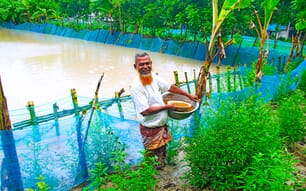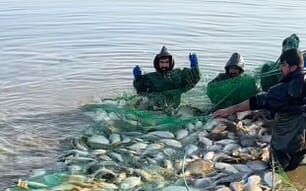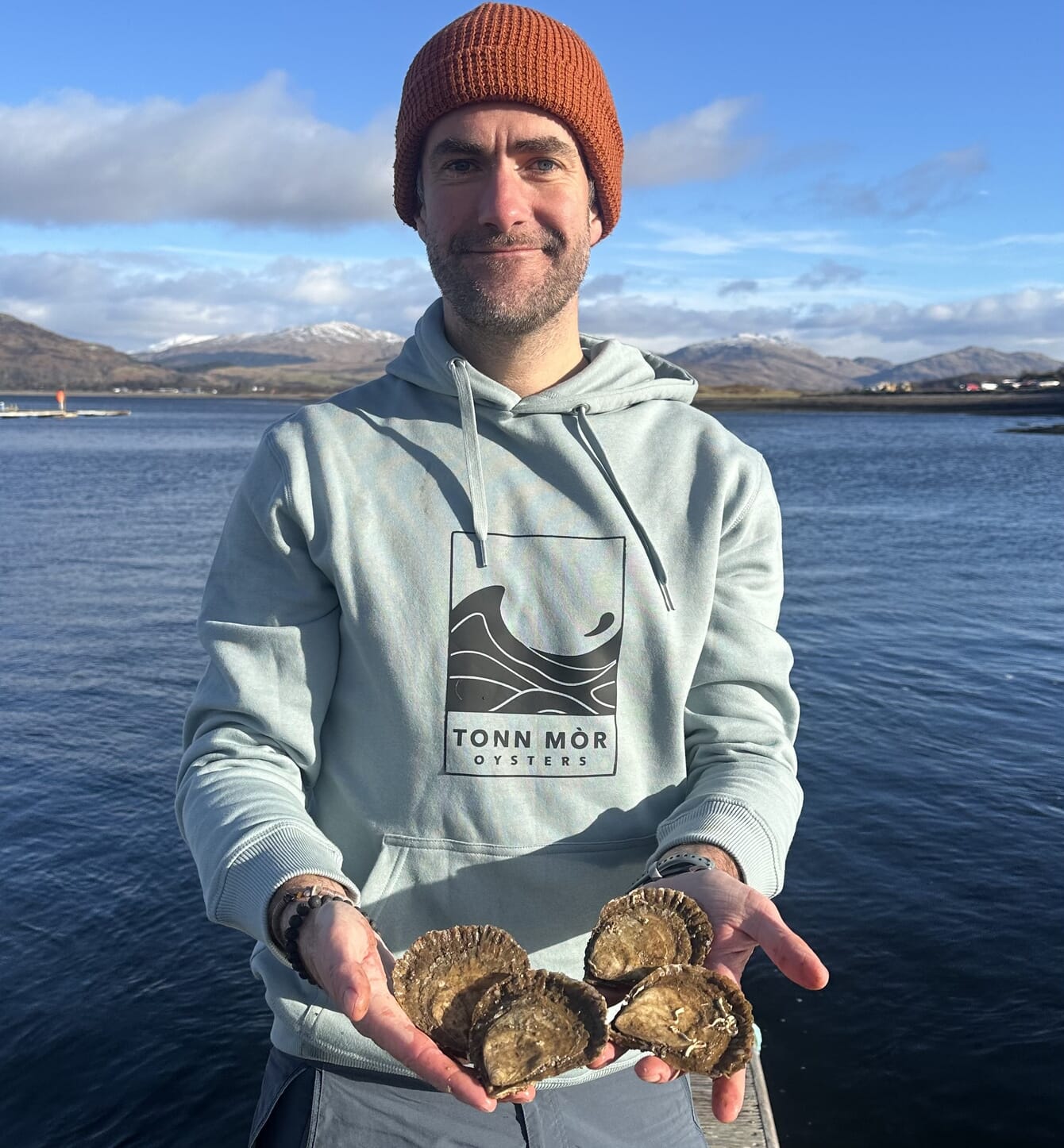
© Tom Ashton
I launched Native Aqua Ltd to harness technology and innovation across the lifecycle from broodstock to harvest, in order to solve the numerous challenges faced by native oyster farmers. At the heart of our business we are crafting a world-class seafood product under the Tonn Mòr brand. The impeccable environmental credentials of native oyster farming also offer a unique opportunity to generate revenue through the growing market for blue offset credits for nutrient removal and biodiversity.
The native, or European flat oyster, was once an abundant food source in the UK and beyond, but due to overfishing and habitat loss, it has become extremely scarce. These oysters form natural reefs that stabilise sediment and provide habitats for diverse marine species. Their decline has had a significant negative impact on coastal ecosystems. However, oyster farming is inherently beneficial to the environment. The farm structures provide shelter for many species of fish, invertebrates, and algae. The process itself is sustainable - oysters require no feed, chemicals or medicines, and they produce no waste. They filter vast amounts of water, capturing nutrients and sequestering carbon. What’s even more remarkable is that native oysters start spawning naturally about halfway through the production cycle. Even though only a tiny fraction of the larvae survive to adulthood, even a small oyster farm can contribute millions of settled oysters to the wild, significantly multiplying its environmental impact in a permanent and sustainable way.
One of the key challenges in farming native oysters is that they remain a wild-type animal—there has never been a successful selective breeding programme to improve commercial traits such as growth and robustness. Almost every other farmed species has been enhanced through selective breeding, but native oysters remain largely unchanged. With my background in aquaculture genetics as a co-founder of Xelect, I have worked on selective breeding programmes for numerous marine species. My previous genetic studies with native oysters have shown that certain broodstock produce significantly faster-growing offspring, proving that growth is a heritable trait, which is entirely normal in many animal species. Through years of handling breeding programmes worldwide, I have learned that any mortality event that is less than 100 percent is an opportunity. The few that survive a disease outbreak or stress challenges likely have heritable advantages and should be considered valuable for future breeding.
In 2023, I began learning oyster farming from scratch under the guidance of John Hamilton of Lochnell Oysters. I embraced traditional Scottish techniques and added an international perspective, travelling to the USA, Australia, and France to tour farms and meet farmers. These experiences provided me with a wealth of ideas and inspiration to design and build a floating farm in the Scottish Highlands. We are currently using Pacific oysters to establish the business and refine farming techniques, meanwhile we are building a bespoke broodstock of natives, proven to be fast growing and tougher than average. Seed supply is currently a massive limiting factor in native oyster farming – but we are building an exciting partnership with another Scottish company to ensure a bio-secure supply of quality seed for generations to come.
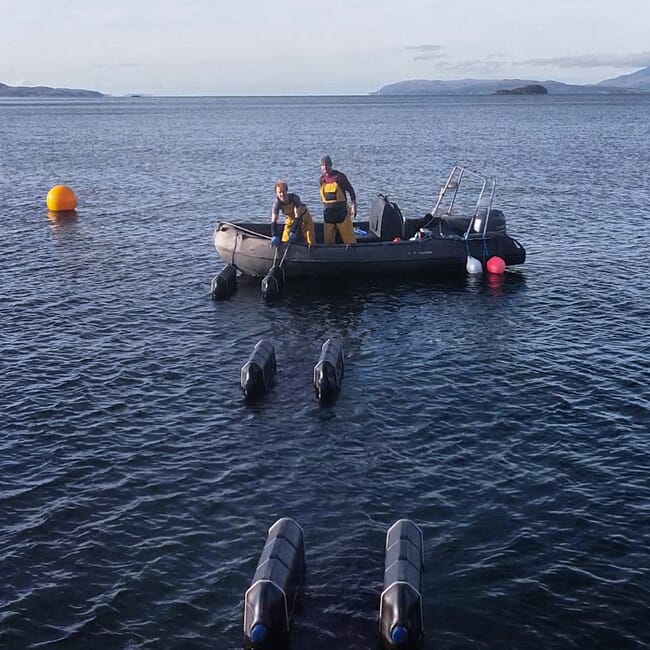
Whilst Ashton and his team are initially farming the Pacific oyster, they are rearing native broodstock to provide seed in the near future © Tom Ashton
The farm is built around the Canadian Oystergro system, which uses large aluminium cages suspended in deep water on longlines, kept afloat by buoys. Each cage can hold 1,200 harvest-sized oysters. The cages need to be flipped upside-down for 24hrs on a weekly basis during the summer months, to kill off biofouling. This is usually done from a boat, but it can be done by swimming along the lines and using bodyweight to flip the cages. I learned this trick in Maine and it is not only effective but great fun. The cages are positioned in direct south-westerly exposure to the open Atlantic so the wave and swell action can be considerable. We engineered our moorings with this in mind, and the Oystergro kit is very heavy duty and built to take a beating. The motion of the waves causes continuous tumbling on the oysters which enhances quality by keeping their shells neat, free of fouling, and naturally polished. The result is a high meat yield and a sweet flavour and firm texture due to a well-developed adductor muscle.
We are marketing Native Aqua’s seafood products under the Tonn Mòr brand, which means “big wave” in Gaelic. This name reflects the high-energy approach to farming oysters in the ocean waves, a method that is already delivering exceptional results. The company recently won a special award at The Association of Scottish Shellfish Growers' annual competition and has been chosen to supply oysters at the 2025 Michelin Star awarding ceremony in Glasgow, where all the top chefs in the country are invited to receive their stars (and try our oysters). This is a huge honour for our young business, and testament to all the hard work we’ve put in so far.
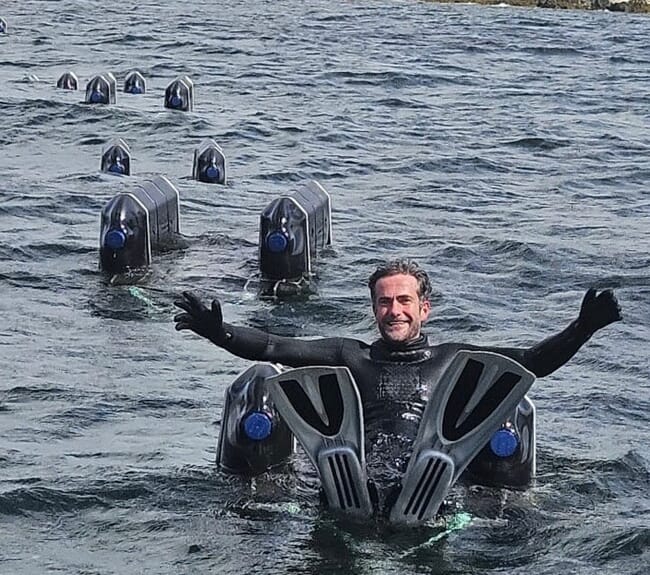
© Tom Ashton
Beyond seafood, we’ve identified a significant opportunity in selling offset credits for nutrient removal and biodiversity enhancement. The global market for environmental credits is expanding rapidly, and companies looking to offset their environmental impact can invest in beneficial projects. A single oyster filters around 100 litres of water per day, removing phytoplankton and sequestering nitrogen and phosphorous. Over their lifespan, a farm full of oysters filters billions of litres of water, while their naturally settled offspring multiply this effect many times over. This is far from being a new idea - Chesapeake Bay, USA, is a great example of a successful nutrient trading scheme, where farmed oysters were used as an offset opportunity for polluting businesses.
It is estimated that one million settled oysters provide the equivalent of one hectare of biodiversity improvement, which holds considerable value in the offset credit market. In the UK for example, the biodiversity net gain (BNG) scheme is a legally mandated scheme whereby developers must calculate their biodiversity impact and invest in suitable offset schemes. More research is needed to precisely quantify the benefits of our farm, but the potential is enormous.
At Native Aqua scientific collaboration is in our DNA. We have partnered with Esox Biologics to run a long-term monitoring program that screens for DNA traces of all living organisms in the water. This research will help optimise farm management while also providing critical data to validate the biodiversity benefits of my operations. Additionally, we are testing a blockchain-based system to track the genetic signature of each oyster batch and associated credit sale, ensuring transparency and permanence in the offset credit market.
There are undoubtedly many challenges ahead and making native oyster farming a commercial success will not be easy. However, by combining selective breeding, innovative farming techniques and scientific research, I’m confident that Native Aqua can help restore this keystone species while creating a thriving, sustainable business.


